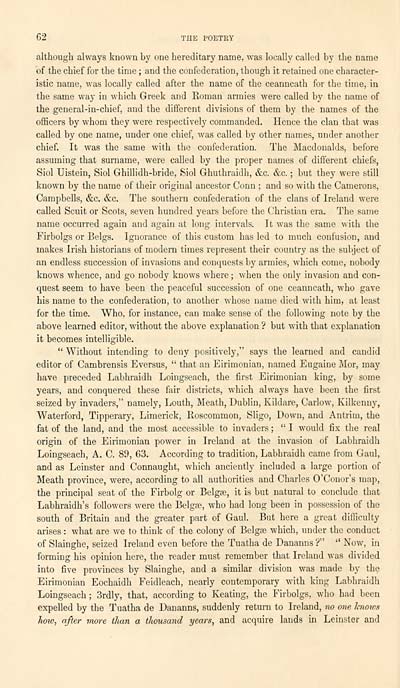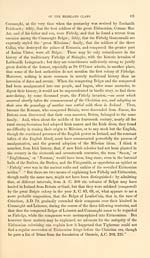Download files
Complete book:
Individual page:
Thumbnail gallery: Grid view | List view

62 TUE POETRY
although always known by one hereditary name, was locally called by the name
of the chief for the time ; and the confederation, though it retained one character-
istic name, was locally called after the name of the ceanncath for the time, in
the same way in which Greek and Eoman armies were called by the name of
the general-in-chief, and the different divisions of them by the names of the
oiHcers by whom they were respectively commanded. Hence the clan that was
called by one name, under one chief, was called by other names, under another
chief. It was the same with the confederation. The Macdonalds, before
assuming that surname, were called by the proper names of different chiefs,
Siol Uistein, Siol Ghillidh-bride, Siol Ghuthraidh, &c. &c. ; but they were still
known by the name of their original ancestor Conn ; and so with the Camerons,
Campbells, &c. &c. The southern confederation of the clans of Ireland were
called Scuit or Scots, seven hundred years before the Christian era. The same
name occurred again and again at long intervals. It was the same with the
Firbolgs or Belgs. Ignorance of this custom has led to much confusion, and
makes Irish historians of modern times represent their country as the subject of
an endless succession of invasions and conquests by armies, which come, nobody
knows whence, and go nobody knows where ; when the only invasion and con-
quest seem to have been the peaceful succession of one ceanncath, who gave
his name to the confederation, to another whose name died with him, at least
for the time. Who, for instance, can make sense of the following note by the
above learned editor, without the above explanation ? but with that explanation
it becomes intelligible.
" Without intending to deny positively," says the learned and candid
editor of Cambrensis Eversus, " that an Eirimonian, named Eugaine Mor, maj'
have preceded Labhraidh Loingseach, the first Eirimonian king, by some
years, and conquered these fair districts, which always have been the first
seized by invaders," namely, Louth, Meath, Dublin, Kiklare, Carlow, Kilkenny,
Waterford, Tipperary, Limerick, Roscommon, Sligo, Down, and Antrim, the
fat of the land, and the most accessible to invaders ; " I would fix the real
origin of the Eirimonian power in Ireland at the invasion of Labhraidh
Loingseach, A. C. 89, 63. According to tradition, Labhraidh came from Gaul,
and as Leinster and Connaught, which anciently included a large portion of
Meath province, were, according to all authorities and Charles O'Couor's map,
the principal seat of the Firbolg or Belgas, it is but natural to conclude that
Labhraidh's followers were the Belga?, who had long been in possession of the
south of Britain and the greater part of Gaul. But here a great difficulty
arises : what are we to think of the colony of Belgre which, under the conduct
of Slainghe, seized Ireland even before the Tuatha de Dananns ?" " Now, in
forming his opinion here, the reader must remember that Ireland was divided
into five provinces by Slainghe, and a similar division was made by the
Eirimonian Eochaidh Feidleach, nearly contemporary with king Labhraidh
Loingseach ; 3rdly, that, according to Keating, the Firbolgs, who had been
expelled by the Tuatha de Dananns, suddenly return to Ireland, 7io one Imows
hoiv, after more than a thousand years, and acquire lands in Leinster and
although always known by one hereditary name, was locally called by the name
of the chief for the time ; and the confederation, though it retained one character-
istic name, was locally called after the name of the ceanncath for the time, in
the same way in which Greek and Eoman armies were called by the name of
the general-in-chief, and the different divisions of them by the names of the
oiHcers by whom they were respectively commanded. Hence the clan that was
called by one name, under one chief, was called by other names, under another
chief. It was the same with the confederation. The Macdonalds, before
assuming that surname, were called by the proper names of different chiefs,
Siol Uistein, Siol Ghillidh-bride, Siol Ghuthraidh, &c. &c. ; but they were still
known by the name of their original ancestor Conn ; and so with the Camerons,
Campbells, &c. &c. The southern confederation of the clans of Ireland were
called Scuit or Scots, seven hundred years before the Christian era. The same
name occurred again and again at long intervals. It was the same with the
Firbolgs or Belgs. Ignorance of this custom has led to much confusion, and
makes Irish historians of modern times represent their country as the subject of
an endless succession of invasions and conquests by armies, which come, nobody
knows whence, and go nobody knows where ; when the only invasion and con-
quest seem to have been the peaceful succession of one ceanncath, who gave
his name to the confederation, to another whose name died with him, at least
for the time. Who, for instance, can make sense of the following note by the
above learned editor, without the above explanation ? but with that explanation
it becomes intelligible.
" Without intending to deny positively," says the learned and candid
editor of Cambrensis Eversus, " that an Eirimonian, named Eugaine Mor, maj'
have preceded Labhraidh Loingseach, the first Eirimonian king, by some
years, and conquered these fair districts, which always have been the first
seized by invaders," namely, Louth, Meath, Dublin, Kiklare, Carlow, Kilkenny,
Waterford, Tipperary, Limerick, Roscommon, Sligo, Down, and Antrim, the
fat of the land, and the most accessible to invaders ; " I would fix the real
origin of the Eirimonian power in Ireland at the invasion of Labhraidh
Loingseach, A. C. 89, 63. According to tradition, Labhraidh came from Gaul,
and as Leinster and Connaught, which anciently included a large portion of
Meath province, were, according to all authorities and Charles O'Couor's map,
the principal seat of the Firbolg or Belgas, it is but natural to conclude that
Labhraidh's followers were the Belga?, who had long been in possession of the
south of Britain and the greater part of Gaul. But here a great difficulty
arises : what are we to think of the colony of Belgre which, under the conduct
of Slainghe, seized Ireland even before the Tuatha de Dananns ?" " Now, in
forming his opinion here, the reader must remember that Ireland was divided
into five provinces by Slainghe, and a similar division was made by the
Eirimonian Eochaidh Feidleach, nearly contemporary with king Labhraidh
Loingseach ; 3rdly, that, according to Keating, the Firbolgs, who had been
expelled by the Tuatha de Dananns, suddenly return to Ireland, 7io one Imows
hoiv, after more than a thousand years, and acquire lands in Leinster and
Set display mode to: Large image | Transcription
Images and transcriptions on this page, including medium image downloads, may be used under the Creative Commons Attribution 4.0 International Licence unless otherwise stated. ![]()
| Early Gaelic Book Collections > Blair Collection > Treatise on the language, poetry, and music of the Highland clans > (74) |
|---|
| Permanent URL | https://digital.nls.uk/76237217 |
|---|
| Description | A selection of books from a collection of more than 500 titles, mostly on religious and literary topics. Also includes some material dealing with other Celtic languages and societies. Collection created towards the end of the 19th century by Lady Evelyn Stewart Murray. |
|---|
| Description | Selected items from five 'Special and Named Printed Collections'. Includes books in Gaelic and other Celtic languages, works about the Gaels, their languages, literature, culture and history. |
|---|

